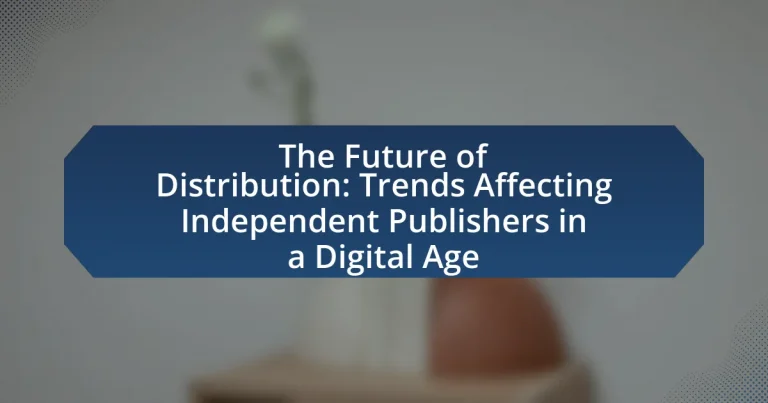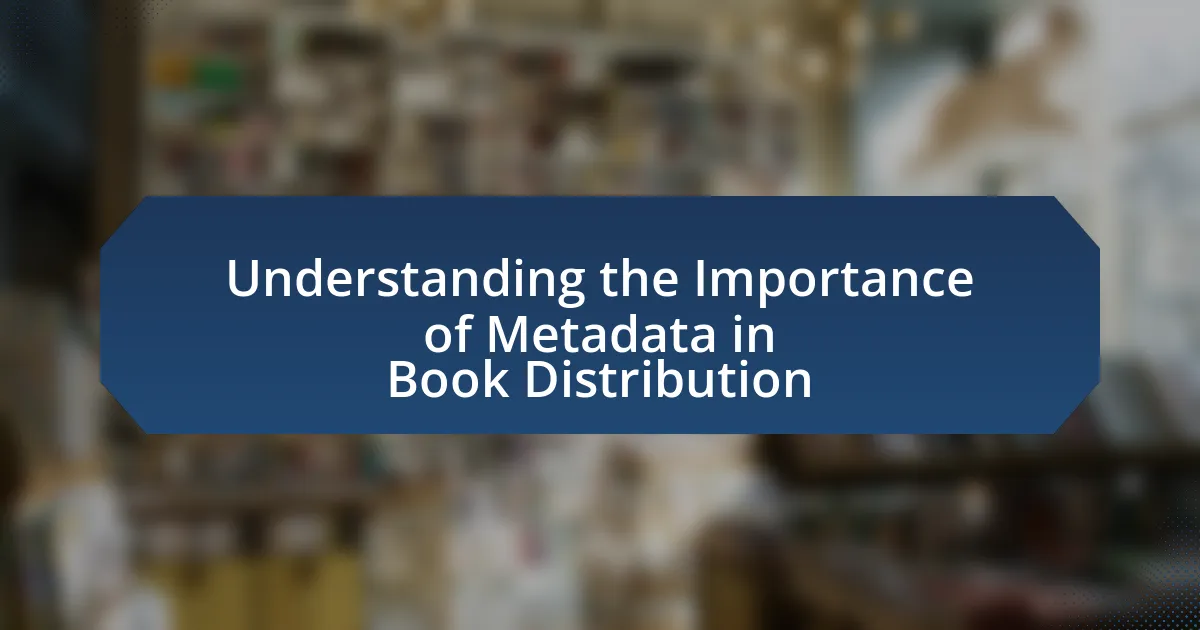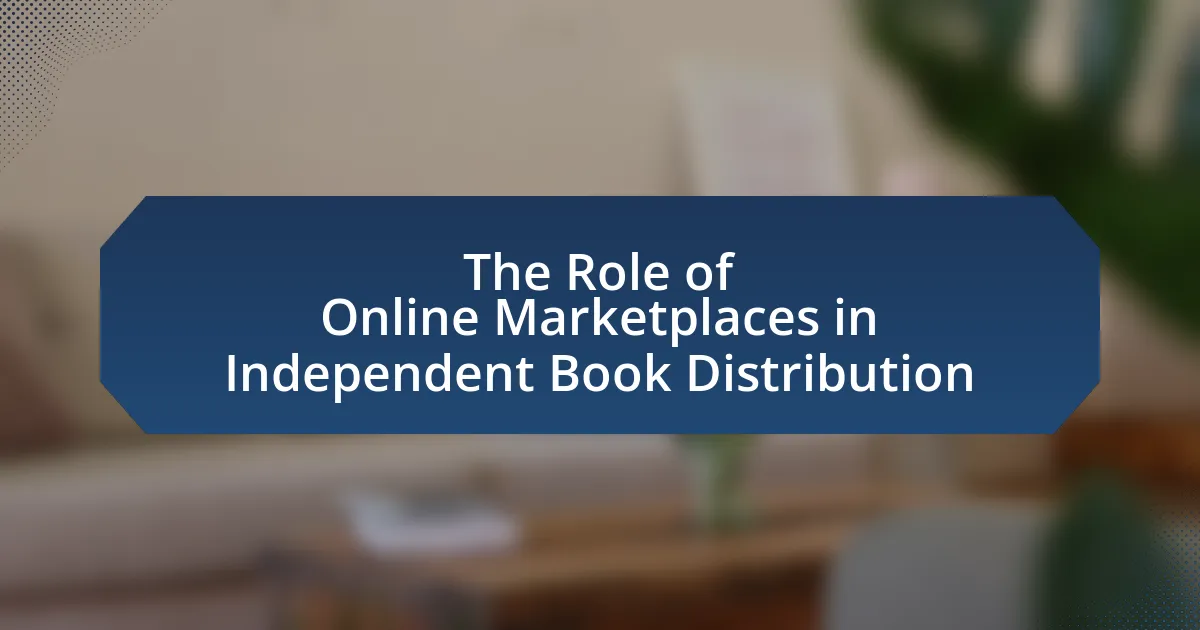The article focuses on the evolving distribution landscape for independent publishers in the digital age. It highlights current trends such as the shift to digital platforms, direct-to-consumer sales, and the adoption of print-on-demand services, which enhance accessibility and profitability. Key technologies like blockchain, artificial intelligence, and cloud computing are discussed for their roles in optimizing distribution methods. The article also addresses the challenges independent publishers face, including competition from larger publishers and market saturation, while outlining strategies for leveraging digital marketing and data analytics to improve distribution effectiveness. Additionally, it explores funding options and best practices for successful digital distribution.

What are the current trends in distribution for independent publishers?
Current trends in distribution for independent publishers include a significant shift towards digital platforms, direct-to-consumer sales, and the use of print-on-demand services. Digital platforms, such as Amazon Kindle Direct Publishing and other e-book retailers, allow independent publishers to reach a global audience with lower upfront costs. Direct-to-consumer sales through websites and social media enable publishers to build stronger relationships with readers and retain a larger share of profits. Print-on-demand services reduce inventory risks and allow for more flexible publishing options, catering to niche markets. These trends reflect the evolving landscape of publishing, where technology plays a crucial role in enhancing accessibility and profitability for independent publishers.
How is digital technology reshaping distribution channels?
Digital technology is reshaping distribution channels by enabling direct-to-consumer sales and enhancing supply chain efficiency. E-commerce platforms allow independent publishers to bypass traditional retail intermediaries, reaching readers directly and increasing profit margins. Additionally, data analytics tools provide insights into consumer behavior, allowing for targeted marketing and personalized recommendations, which further optimize distribution strategies. According to a report by Statista, global e-commerce sales are projected to reach $6.54 trillion by 2022, highlighting the significant shift towards digital channels in distribution.
What specific technologies are influencing distribution methods?
Specific technologies influencing distribution methods include blockchain, artificial intelligence, and cloud computing. Blockchain enhances transparency and security in supply chains, allowing for real-time tracking of products. Artificial intelligence optimizes inventory management and demand forecasting, improving efficiency in distribution processes. Cloud computing facilitates scalable storage and access to data, enabling publishers to manage distribution networks more effectively. These technologies collectively streamline operations, reduce costs, and enhance customer satisfaction in the distribution landscape.
How do these technologies impact the reach of independent publishers?
Technologies such as digital platforms, social media, and e-commerce significantly enhance the reach of independent publishers. These tools enable publishers to distribute their content globally without the constraints of traditional distribution channels. For instance, platforms like Amazon Kindle Direct Publishing allow independent authors to publish and sell their books directly to consumers, reaching millions of potential readers. Additionally, social media channels facilitate targeted marketing, enabling publishers to connect with niche audiences effectively. According to a 2021 report by the Independent Publishers Guild, independent publishers utilizing digital marketing strategies saw a 30% increase in audience engagement compared to those relying solely on traditional methods. This evidence underscores the transformative impact of technology on the distribution capabilities of independent publishers.
What role do social media and online platforms play in distribution?
Social media and online platforms serve as critical channels for distribution by enabling independent publishers to reach wider audiences efficiently. These platforms facilitate direct engagement with consumers, allowing publishers to share content, promote products, and build brand loyalty without the need for traditional intermediaries. For instance, according to a 2021 report by the Pew Research Center, 69% of adults in the U.S. use social media, highlighting its potential as a vast audience for content distribution. Additionally, online platforms like Amazon and Etsy provide marketplaces where independent publishers can sell their works directly to consumers, further enhancing distribution capabilities.
How can independent publishers leverage social media for distribution?
Independent publishers can leverage social media for distribution by creating targeted content that engages their audience and promotes their publications. By utilizing platforms like Facebook, Twitter, and Instagram, independent publishers can reach specific demographics, share updates, and foster community engagement. For instance, a study by the Pew Research Center indicates that 69% of adults in the U.S. use social media, providing a vast audience for publishers to tap into. Additionally, using analytics tools available on these platforms allows publishers to track engagement and refine their strategies based on audience preferences, enhancing their distribution effectiveness.
What are the challenges of using online platforms for distribution?
The challenges of using online platforms for distribution include intense competition, reliance on algorithms, and issues with data privacy. Intense competition arises as numerous publishers vie for visibility, making it difficult for independent publishers to stand out. Reliance on algorithms can lead to unpredictable changes in visibility and reach, as platforms frequently update their ranking criteria, impacting sales and audience engagement. Additionally, data privacy concerns have increased, with regulations like GDPR affecting how publishers collect and use consumer data, potentially limiting marketing strategies and audience targeting.
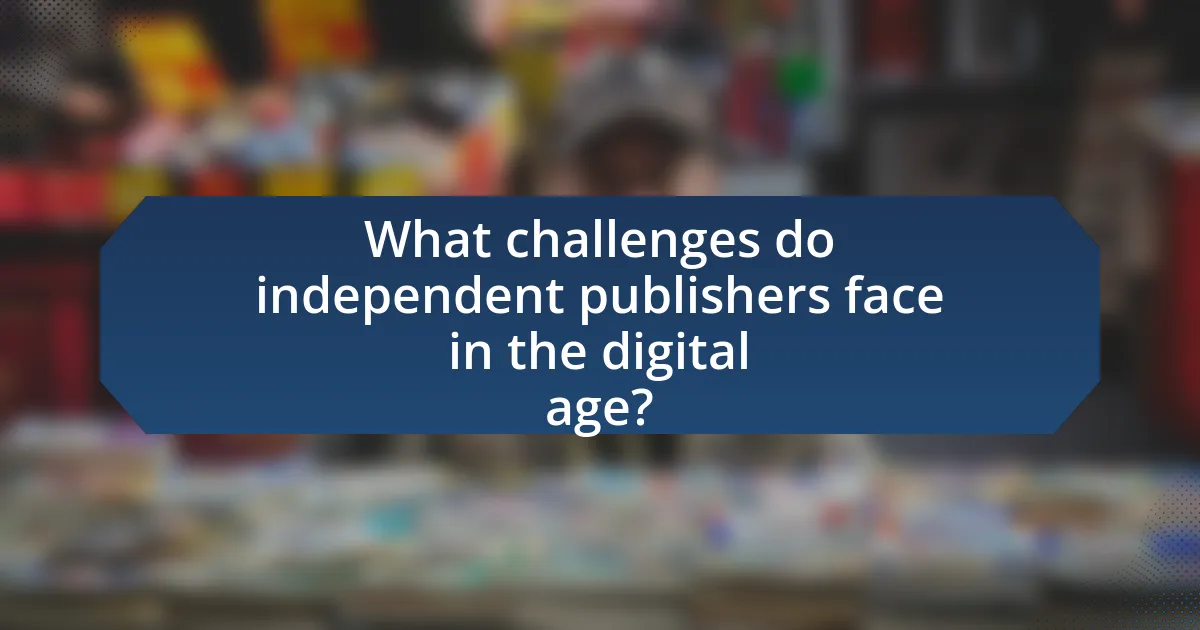
What challenges do independent publishers face in the digital age?
Independent publishers face significant challenges in the digital age, primarily due to competition from larger publishing houses and the dominance of online platforms. These larger entities often have greater resources for marketing, distribution, and technology, making it difficult for independent publishers to gain visibility. Additionally, the rise of digital content has led to issues such as piracy and the devaluation of books, which can undermine sales. According to a 2021 report by the Independent Publishers Guild, 70% of independent publishers reported that competition from online retailers significantly impacted their sales. Furthermore, independent publishers often struggle with limited budgets for digital marketing and technology investments, which are crucial for reaching audiences effectively in a crowded marketplace.
How does competition from larger publishers affect independent publishers?
Competition from larger publishers significantly impacts independent publishers by limiting their market share and access to distribution channels. Larger publishers often have greater resources, allowing them to invest in marketing, technology, and distribution networks that independent publishers cannot match. For instance, according to a 2021 report by the Association of American Publishers, the top five publishers control over 80% of the market, making it challenging for smaller entities to gain visibility and sales. This dominance can lead to reduced shelf space in bookstores and less favorable terms from distributors, further disadvantaging independent publishers.
What strategies can independent publishers adopt to compete effectively?
Independent publishers can adopt strategies such as leveraging digital marketing, building niche communities, and utilizing print-on-demand technology to compete effectively. Digital marketing allows independent publishers to reach targeted audiences through social media and online advertising, increasing visibility and sales. Building niche communities fosters loyalty and engagement, enabling publishers to connect directly with readers who share specific interests. Print-on-demand technology reduces upfront costs and inventory risks, allowing publishers to offer a wider range of titles without significant financial investment. These strategies are supported by the growing trend of online book sales, which accounted for over 30% of total book sales in the U.S. in 2022, highlighting the importance of digital presence for independent publishers.
How does market saturation impact distribution opportunities?
Market saturation significantly limits distribution opportunities by creating intense competition among publishers. As more products enter the market, the available channels for distribution become overcrowded, making it challenging for independent publishers to secure shelf space or visibility. For instance, a study by the Book Industry Study Group found that in saturated markets, smaller publishers often struggle to compete with larger entities that have established relationships with distributors and retailers. This competition can lead to reduced margins and fewer promotional opportunities, ultimately constraining the ability of independent publishers to reach their target audiences effectively.
What are the financial implications of digital distribution for independent publishers?
Digital distribution significantly reduces costs for independent publishers by eliminating expenses associated with physical printing, storage, and shipping. This shift allows publishers to allocate resources more efficiently, focusing on marketing and content development. For instance, a study by the Association of American Publishers indicated that digital formats can lower production costs by up to 50%, enabling independent publishers to offer competitive pricing and reach wider audiences. Additionally, digital platforms provide access to global markets, increasing potential revenue streams. The ability to update content easily and respond to market trends further enhances financial viability, making digital distribution a crucial strategy for independent publishers in the evolving landscape.
How can independent publishers manage costs associated with digital distribution?
Independent publishers can manage costs associated with digital distribution by utilizing cost-effective platforms and optimizing their distribution strategies. By selecting platforms that offer lower fees or revenue-sharing models, such as Amazon Kindle Direct Publishing or Smashwords, publishers can reduce upfront costs. Additionally, leveraging social media and email marketing for direct sales minimizes reliance on third-party retailers, further decreasing distribution expenses. Research indicates that independent publishers who adopt a multi-platform approach can increase their market reach while controlling costs, as evidenced by a 2021 survey from the Independent Book Publishers Association, which found that 60% of successful independent publishers use multiple distribution channels to maximize profitability.
What funding options are available for independent publishers navigating digital distribution?
Independent publishers navigating digital distribution have several funding options available, including crowdfunding, grants, and partnerships with established platforms. Crowdfunding platforms like Kickstarter and Indiegogo allow publishers to raise funds directly from their audience, enabling them to gauge interest and secure financial backing before launching projects. Additionally, various organizations and government bodies offer grants specifically aimed at supporting independent publishing, such as the National Endowment for the Arts in the United States, which provides funding for literary projects. Furthermore, partnerships with established digital distribution platforms can provide financial support and resources, as these platforms often have programs designed to assist independent publishers in reaching wider audiences.
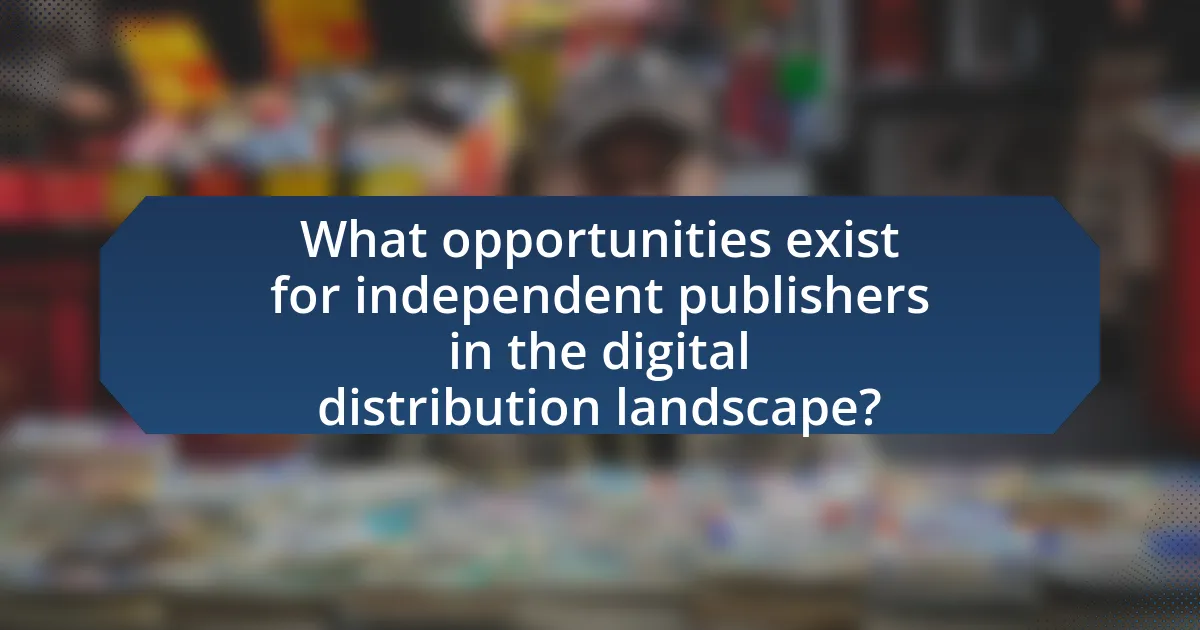
What opportunities exist for independent publishers in the digital distribution landscape?
Independent publishers have significant opportunities in the digital distribution landscape, primarily through direct-to-consumer sales, access to global markets, and the ability to leverage data analytics for targeted marketing. Direct-to-consumer sales enable independent publishers to retain a larger share of profits by selling eBooks and audiobooks through their own websites or platforms like Amazon Kindle Direct Publishing. Access to global markets allows these publishers to reach diverse audiences without the constraints of traditional distribution channels, as digital platforms facilitate international sales. Furthermore, data analytics tools provide insights into reader preferences and behaviors, enabling independent publishers to tailor their marketing strategies effectively, which can lead to increased sales and reader engagement.
How can independent publishers utilize data analytics for better distribution?
Independent publishers can utilize data analytics to enhance distribution by analyzing reader preferences and market trends to optimize their distribution strategies. By leveraging data analytics tools, publishers can track sales patterns, identify target demographics, and assess the effectiveness of various distribution channels. For instance, a study by the Pew Research Center indicates that 70% of consumers prefer personalized content, which can be achieved through data-driven insights. This allows independent publishers to tailor their marketing efforts and distribution methods, ensuring that their products reach the right audience at the right time, ultimately increasing sales and visibility in a competitive market.
What types of data should independent publishers focus on?
Independent publishers should focus on audience engagement data, sales performance metrics, and content consumption analytics. Audience engagement data, such as social media interactions and website traffic, helps publishers understand reader preferences and tailor content accordingly. Sales performance metrics, including sales trends and revenue sources, provide insights into what products are most profitable and guide future publishing decisions. Content consumption analytics, which track how readers interact with published materials, reveal which formats and topics resonate most, enabling publishers to optimize their offerings. These data types are essential for making informed decisions in the evolving digital landscape.
How can data-driven decisions enhance distribution strategies?
Data-driven decisions can enhance distribution strategies by enabling publishers to optimize their supply chain and target audiences more effectively. By analyzing data on consumer behavior, sales trends, and inventory levels, independent publishers can identify the most profitable distribution channels and tailor their offerings to meet market demand. For instance, a study by McKinsey & Company found that companies leveraging data analytics in their distribution processes can achieve up to a 15% increase in operational efficiency. This evidence supports the assertion that data-driven insights lead to more informed decisions, ultimately improving distribution effectiveness and profitability for independent publishers in the digital age.
What best practices should independent publishers follow for successful digital distribution?
Independent publishers should prioritize building a strong online presence for successful digital distribution. This involves creating a professional website that showcases their catalog, utilizing social media platforms to engage with readers, and optimizing content for search engines to increase visibility. According to a study by the Pew Research Center, 72% of adults in the U.S. use social media, highlighting its importance in reaching potential audiences. Additionally, independent publishers should consider leveraging multiple digital distribution channels, such as eBook platforms and online retailers, to maximize reach. Research from the Association of American Publishers indicates that eBook sales have consistently grown, emphasizing the need for diverse distribution strategies. Finally, maintaining strong relationships with readers through newsletters and direct marketing can enhance customer loyalty and drive sales.
How can independent publishers build effective partnerships for distribution?
Independent publishers can build effective partnerships for distribution by leveraging digital platforms and collaborating with established distributors. By utilizing platforms like Amazon, IngramSpark, or Draft2Digital, independent publishers can access a wider audience and streamline their distribution processes. Collaborating with established distributors allows independent publishers to benefit from their existing networks and expertise, which can enhance visibility and sales. Research indicates that partnerships with established entities can increase market reach by up to 30%, demonstrating the effectiveness of such collaborations in the competitive landscape of digital publishing.
What are the key elements of a successful digital marketing strategy for distribution?
A successful digital marketing strategy for distribution includes targeted audience segmentation, multi-channel engagement, content optimization, data analytics, and performance measurement. Targeted audience segmentation allows publishers to identify and reach specific demographics, enhancing relevance and engagement. Multi-channel engagement ensures that content is distributed across various platforms, such as social media, email, and websites, maximizing visibility. Content optimization involves tailoring messages and formats to suit different channels and audience preferences, which increases effectiveness. Data analytics provides insights into consumer behavior and campaign performance, enabling informed decision-making. Finally, performance measurement through key performance indicators (KPIs) assesses the success of the strategy, allowing for adjustments and improvements. These elements collectively contribute to a robust digital marketing strategy that effectively supports distribution goals for independent publishers in a digital age.
What practical tips can independent publishers implement for effective distribution?
Independent publishers can implement several practical tips for effective distribution, including leveraging digital platforms, building direct relationships with readers, and utilizing data analytics. Digital platforms like Amazon Kindle Direct Publishing and IngramSpark allow independent publishers to reach a global audience efficiently. Establishing direct relationships with readers through newsletters and social media fosters loyalty and encourages word-of-mouth promotion. Additionally, using data analytics helps publishers understand market trends and reader preferences, enabling them to tailor their distribution strategies effectively. These methods have been shown to enhance visibility and sales for independent publishers in the competitive digital landscape.
